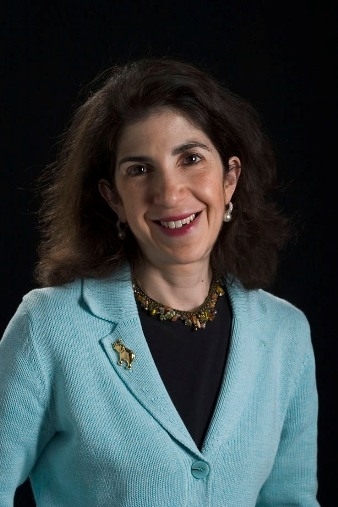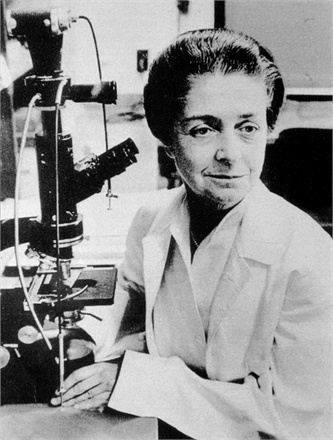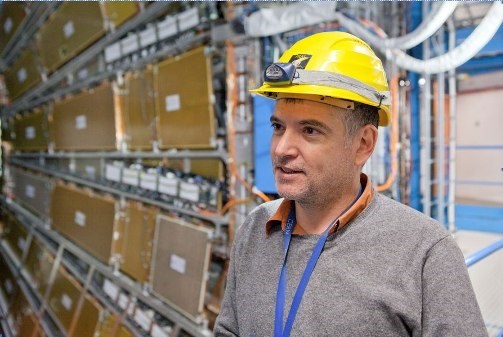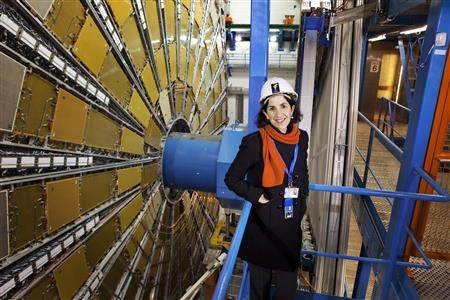 |
| Fabiola Gianotti (CERN) |
Fabriola Gianotti, an Italian particle physicist is the former Spokesperson for the ATLAS Experiment on the Large Hadron Collider (LHC) at CERN. She was in the centre of the media frenzy when the news broke in the summer of 2012 that the illusive "God Particle" had been discovered, the Higgs boson. Women in science are a definite minority so it was quite significant that Gianotti was chosen for this esteemed position on the world stage of science. Gianotti, a classically trained pianist (Milan Conservatory) has said that it is common for physicists to be attracted to music, "Einstein was a very good violinist." Her father, a geologist instilled in her a love of nature on their many walks in nature, through the mountains and beyond, explaining and describing insects and plants and flowers they encountered. Her education in Italy focused on literature, art history, ancient languages and music, "very little mathematics or physics," she said. But her love for philosophy "a discipline that at least asks the fundamental questions," pointed her to physics at University and we are all so glad it did. Gianotti is an advocate for the blending of art and science, one informing the other. She said, "art and physics are much closer than you would think. Art is based on very clear, mathematical principles like proportion and harmony. At the same time, physicists need to be inventive, to have ideas, to have some fantasy." A perk for Gianotti is that she gets to work with scientists from 38 countries, she says, "for me this job is, of course, a great scientific adventure but it's also a great human adventure."
MY HERO recently heard from Fabriola about heroes and kids in science:
"Science, i.e. contributing to the progress of knowledge, is one of the most exciting and noble activities. It requires passion, enthusiasm, dedication and a lot of motivation. If a young person wants to take this path, I can only encourage him/her strongly.
The path is long and difficult; there will be many challenges and dark moments, which need to be addressed with courage and determination. But the satisfaction of contributing to advance the limits of knowledge is extremely rewarding.
Also, be modest. Although mankind has made huge progress, the things we don't know are far more numerous than those we know. Only a modest attitude can push us to give the best of ourselves.
Whatever you choose to do, don't give up on your dreams, as you may regret it later. "
 |
| Fabiola's HERO, Rita Levi Montalcini |
"I don't have one hero; I have several...
Perhaps the one I can mention is Rita Levi Montalcini. Rita was born in Torino (Italy) in 1909 to a Jewish family and died on 30 December 2012. She was a neurologist and was awarded the Nobel Prize in Medicine in 1986 for her work on the nerve growth factor.
In her youth she suffered from the persecution of Jews during that time, so she started her experimental work on nerve fibers in chicken embryos in the basement of her house. She then migrated to the US (St. Louis, Missouri) where she carried out most of her scientific career. But she always claimed that the foundations of her discoveries were laid when she was a young girl working in a rudimental lab at her home.
I admire her for her courage (being a woman, and a Jewish woman, in the first half of last century was not the best entry point for a career in science), her passion for science, her intellectual honesty, and for having put research before everything else (money, success, a comfortable life.).
Steven Goldfarb, who has worked very closely with Fabriola Gianotti steps in for her now to explain in simple terms about the Higgs Boson, the God Particle, what it means to us and future generations and other scientific clarifications."
 |
| Steven Goldfarb in action at CERN (CERN) |
"Do you ever look at things and wonder? What makes the sky blue? Why is the sun hot? What's in a quark? If so, then you are a scientist. You measure things and then ask questions about them.
About 50 years ago some very bright scientists, Robert Brout, Francois Englert and Peter Higgs, asked a very fundamental question: Why do some particles have mass, while others don't? That is, where does mass come from?
They proposed an invisible field everywhere in the universe (even behind the fridge). Particles like electrons or quarks interact with this field, and get mass. Others, like photons, don't even notice the field, and have no mass.
Think of the field like a ski slope. If you are on skis, you are massless. You zip right through without slowing down. If you wear snowshoes, you are a light particle, you can move across the field, but more slowly than the skiers. If you are in boots, you are a very massive particle, and you move slowly.
In quantum mechanics (the science of the microscopic world of particles), fields are made of particles called bosons. Peter Higgs suggested that this must also be true for the new field. To see that particle, we would need to zap the field with enough energy to free one of the bosons.
Sounds easy, right? Two problems: First of all, he could not predict the mass of the new boson (how much energy we would need to free it). Secondly, he knew the chances of hitting the field were very small, and that it would take many attempts to succeed. But, that did not keep us from trying.
Einstein taught us that E = mc2 (energy can become mass). To discover new particles, we build machines called accelerators that smash particle beams together. If the Higgs boson had a high mass, we could produce it by colliding beams at high energy. To find the boson, we built large detectors that surround the collisions and take pictures of what comes out.
Our accelerator is called the Large Hadron Collider at CERN. It can make very high-energy collisions and a lot of them. How many? About 40 million every second! The detectors that looked for the Higgs boson are called ATLAS and CMS.
After looking at 500 trillion collisions (500,000,000,000,000) in 2011 and 2012, both experiments announced the discovery of a boson that looks like what Peter Higgs had predicted so long ago. He and is friend Francois Englert were at CERN to see the announcement. They cried with joy. So did we."
"No scientists refer to the Higgs boson that way. However, the media like to use that nickname, as it makes for a catchy title in a newspaper or magazine. Most of us do not think it is appropriate or even very descriptive.
But the story behind the name is amusing. It comes from the title of a book written by Leon Lederman and Dick Teresi. According to Teresi, he proposed it as the working title for their book after hearing Lederman use the phrase in a lecture. Lederman did not want that title, but Teresi assured him that, in his experience, publishers always reject working titles, so it would be safe. Lederman agreed and now we are stuck with that terrible nickname."
"That is the beauty of fundamental science. We don't know.
Don't be sad. Newton probably did not foresee launching communication satellites or exploring Mars when he came up with gravity. Dirac and Anderson did not predict PET scanners, and even Einstein and Bohr probably did not expect us to carry quantum mechanics and relativity in our iPhones!
What we do know is that finding the Higgs boson and measuring its properties give us a more clear understanding of our universe. We know the origin of mass and thereby the existence of matter. And understanding our world is perhaps one of the most important survival instincts of our species. It explains the big bump on our shoulders!
We also know of all of the applications that have come about during the long hunt for the Higgs boson. In building accelerators, we learned how to use particle beams to treat people with cancer. In building detectors, we learned how to design sensors for medical imaging. In analyzing data, we learned how to connect facilities around the world to act like one big computer. And to share information between thousands of scientists around the world, we developed the worldwide web. And these are only a few examples."
 |
| Fabiola Gianotti (CERN) |
"I am the Education and Outreach Coordinator for ATLAS. What could be more fun than that? O.K. In my spare time, I am a singer in the Canettes Blues Band."
"Touch a scientist and you touch a child." -- Ray Bradbury
"Young children attack life with passion and are not afraid of hiding their enthusiasm. Now, take a look at old photos and video footage of Albert Einstein and Richard Feynman. They hide nothing! They are kids!"
"I think my favourite quote says it all. Human beings have a few key instincts that are necessary for our survival: eating, raising a family, and trying to understand the world around us. From the day we are born, we derive pleasure from all of these pursuits, simply because they are innate.
Some people ask me if, during difficult economic times, it is really necessary to pursue fundamental research. My response is that it is not our choice. It is our nature. If we stop, even temporarily, we are risking our extinction. Our children and our children's children need our discoveries in order to pursue their own. We simply cannot afford to deprive them of these fundamental tools.
The discovery of the Higgs boson is not only a key bit of knowledge about our universe; it is a stepping-stone to future great discoveries. And I can't wait to get the LHC started up again, so that we can find out just what they are!"
Page created on 3/1/2015 2:04:23 PM
Last edited 1/7/2020 7:34:12 PM
